Feature: We Look To The Past To Predict Every First-Party ‘Switch 2’ Release Until 2029
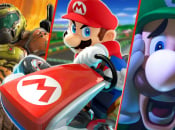
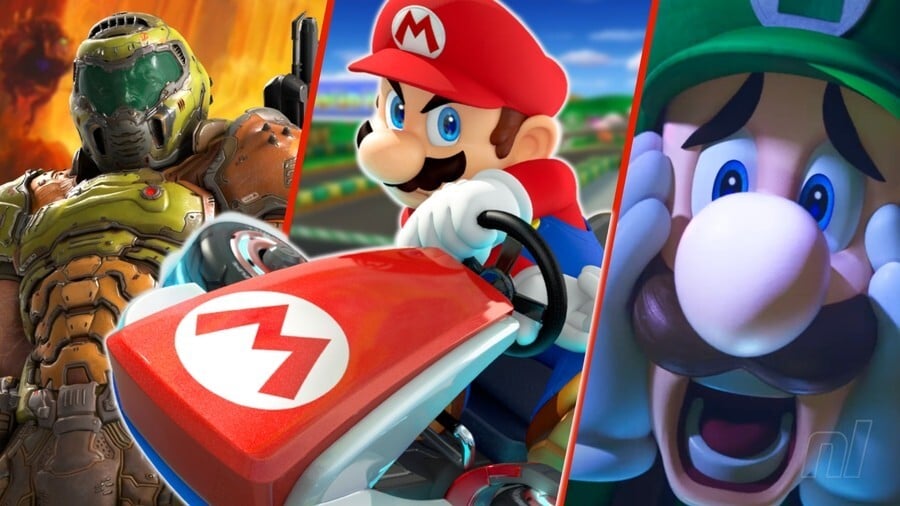
By any measure, the Switch has been a rousing success. It has outsold and outlasted almost every gaming console ever made, but according to Nintendo president Shuntaro Furukawa, its days are now numbered.
Rumors aside, we don’t know exactly what form the “Switch successor” will take, nor even what it will be called. But one thing we know for sure is that it will play games. And Nintendo will make a few of them. What do you say we make an educated guess about which games Nintendo makes, and when each one will launch?
Predicting ‘Switch 2’ Games – The Methodology
Predicting the future is tricky business, but as they say, “the best predictor of future behavior is past behavior.” The key to understanding the Switch 2’s future, therefore, is to find trends and repeated behaviors over Nintendo’s prior seven generations’ worth of game-making. Thankfully, Nintendo has a long history and some remarkably consistent behavior to study.
To discover these trends, we need data. We begin by compiling a list of every game ever produced by Nintendo, and categorizing each title by generation, year of that generation, franchise (Mario, Zelda, Kirby, etc.), and type (mainline, spin-off, remake, etc.). Check out the full breakdown here.
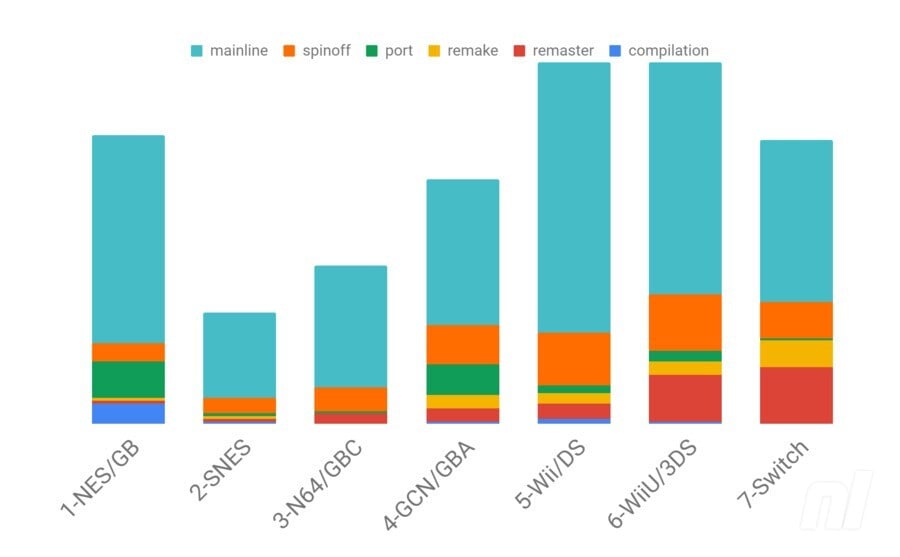
Nintendo has a long history and some remarkably consistent behavior to study
With the raw data collected and categorized, our next step is to find patterns that will give us a window into Nintendo’s schemes. We should look for telling metrics, such as the average number of years between releases per franchise, the number of releases per year per console generation, the average generational year that each franchise receives a mainline release, and the number of releases per franchise per system by type. Many other patterns emerge, but you get the idea.
The end result of this number crunching is a predicted seven-year release schedule of ‘Switch 2’ games. And just for fun, let’s throw in a few naming possibilities and a dash of wishful thinking.
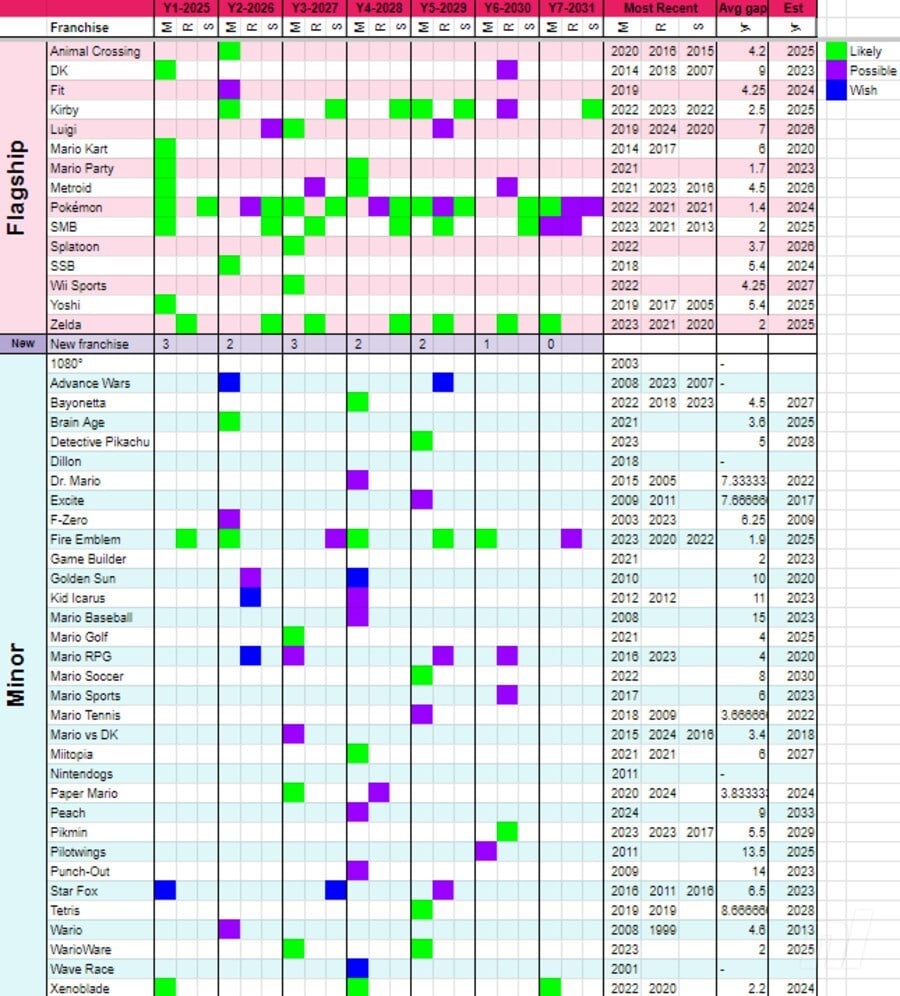
A Few Trends to Remember
Beginning in the GameCube era, Nintendo has followed the pattern below. Keep these trends in mind as we explore each year of the Switch 2’s lifespan.
- In Years 1 through 3, release one game per flagship franchise. Also, introduce a few new IP/franchises
- In Years 4 and beyond, fill the calendar with releases in minor franchises and spinoffs from the flagships. Also, feed consumers with a steady stream of remakes and remasters, particularly during long, successful generations
Now then, let’s dive in!
Year One (2025) – ‘Super Mario Spacetime’
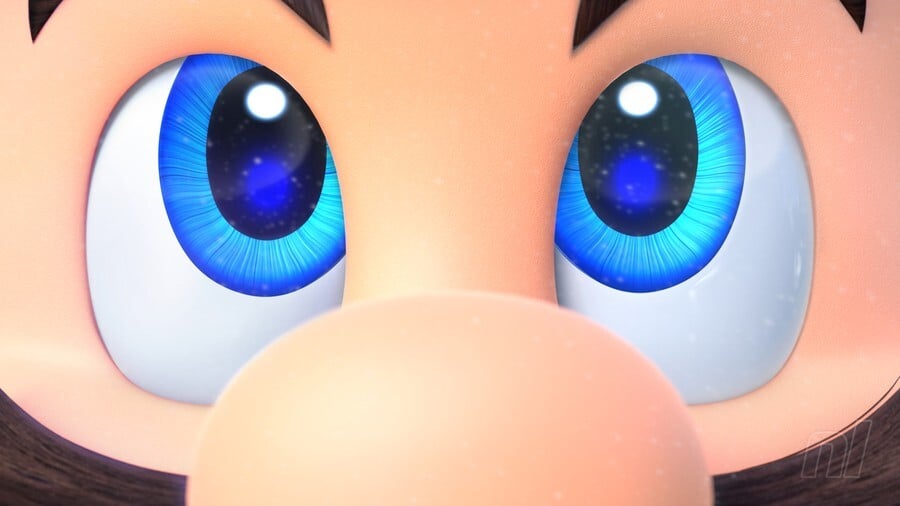
There are three certainties in life: death, taxes, and a mainline Mario game during a Nintendo console’s first year. Mario kicks off Switch 2’s Year One in style with a bold, beautiful journey through his latest frontier – time itself. A fitting way to celebrate Super Mario Bros.‘ 40th anniversary.
The rest of Switch 2’s inaugural outing should look something like this:
- ‘Donkey Kong Slaps’ – DK returns to the third dimension for a long-overdue DK64 apology tour. A decade has passed since we’ve received a mainline DK title. It’s time, and it will be glorious.
- ‘Nintendo Kart’ – For the past 32 years a Mario Kart game has been released in the first or second year of every Nintendo system’s lifespan. This time around, new foes appear, as Mario Kart finally gets the Smash Bros. treatment it so desperately needs.
- Pokémon Legends: Z-A, ‘Mario Party 11’, Metroid Prime 4, ‘Xenoblade Chronicles 4’, Star Fox – We’re either right on track or long overdue to receive new installments in each of these franchises.
- ‘Yoshi’s Fluffy Galaxy’ – Yoshi swallows a new army of enemies every three years or so, and by 2025 he will have been waiting almost twice that long between meals. He’s gonna be hungry!
- Zelda and Fire Emblem Remasters – With a new mainline Zelda title years away, this is the year when the long-rumored remaster of either Wind Waker or Twilight Princess finally hits. Either that, or an upscaled Breath of the Wild or Tears of the Kingdom. The Fire Emblem series is also due for a release and gets one when Genealogy of the Holy War is remade… as an action RPG.
- Three new IPs – Early-gen new IPs are a reliable tradition for the big N, as anywhere from one-third to one-half of its new ideas are released in Year One. The number of these games has been dropping since the innovative years of the DS and Wii to the point where the Switch era saw Nintendo’s smallest number of new ideas ever.
Year Two (2026) ‘Super Smash Bros. Eternal’
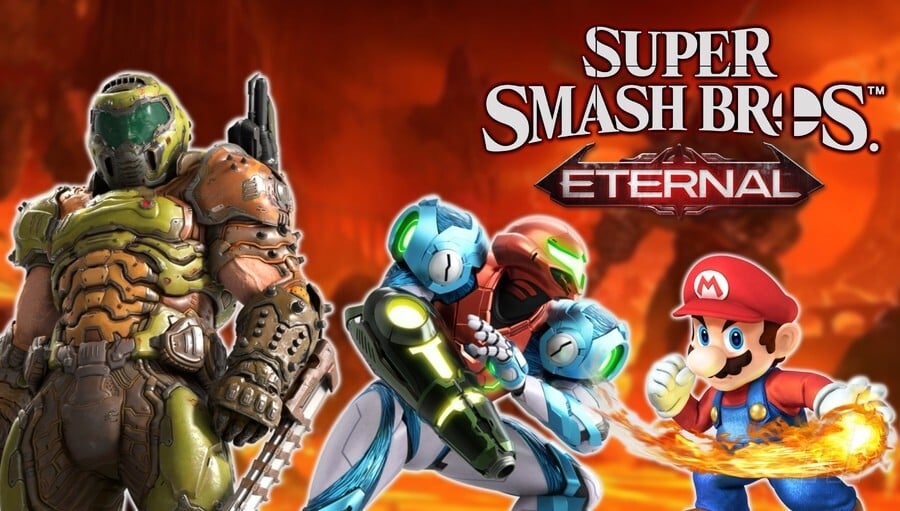
Smash has hit everywhere from Year One (GameCube) to Year Four (3DS) but as one of Nintendo’s biggest sellers, we think it’s a safe bet for this franchise to be the headliner for Year Two, just as it was for Switch.
Nintendo’s pipeline ramps up significantly this year. Major releases in Year Two should include:
- ‘Kirby’s Forgotten Again’ – Kirby and Yoshi rarely see launches in the same year, so with Yoshi appearing in Year One, it’s Kirby’s turn to be remembered in this Forgotten Lands sequel.
- ‘Animal Crossing: Astronaut’ – AC is now a bonafide flagship for Nintendo, so it won’t wait until Year Four like last time. Animal Crossing blasts off toward uncharted yet cozy worlds.
- ‘Super Mario Maker 3D’ – Yeah, the community beat it to the idea, but we think Nintendo got the hint.
- Two new IPs appear, just as Wii Fit, Bayonetta (sort of), and Labo did during the Wii, Wii U, and Switch generations, respectively.
And the rest of the franchises that are on track for a 2026 installment:
- ‘Nintendo Fit Hula Hoop’ – It wouldn’t be a Nintendo console without a gimmicky peripheral.
- ‘Fire Emblem Encounter’ – In 2026 we’re a year overdue for a new FE title. Intelligent Systems experiments with group-based units in its latest mainline release.
- Spin-offs – Princess Zelda and 2D Luigi take starring roles in their own adventures. Pokémon averages a new spin-off title every nine months, although this pace has started to slow. Nintendo will keep releasing them as long as Game Freak cranks them out.
- Series Revivals – Wario Land and F-Zero franchises each make a glorious return to relevancy. Who needs new IPs when you can mine for gold in your own basement?
- A handful of remakes and remasters appear. A Mario & Luigi game, the fifth generation of Pokémon (Black & White), and one or both Golden Sun titles get a new lease on life.
Year Three (2027) – 4 The Win
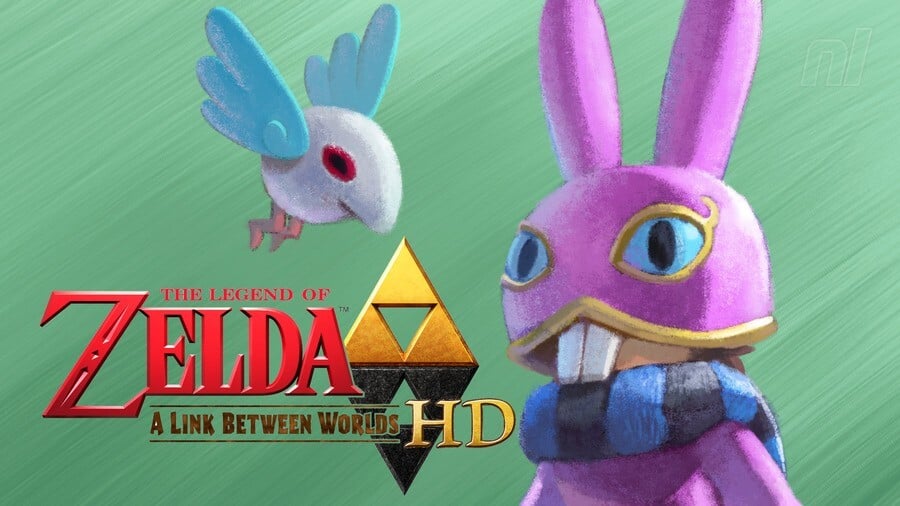
The hits keep rolling in Year Three, as Nintendo checks off most of their remaining flagship franchises.
- Luigi’s Mansion and Splatoon both learn to count to 4, with Mario’s brother taking on an entire ‘Ghost Town’, and ‘Splatoon 4’ adding a battle royale mode.
- Kirby gets a new spin-off in the form of ‘Kirby Puzzle Panic’, a collection of original and remastered versions of the pink puffball’s past puzzlers (Dream Course, Avalanche, Block Ball, Star Stacker, Tilt ‘n’ Tumble).
- The names for ‘Pokémon Health and ‘Fitness’ make their theme perfectly clear, as Game Freak takes a slightly longer than usual development cycle before inviting us into the tenth generation.
- ‘A Link Between Worlds HD’ continues Nintendo’s annual tradition of Zelda releases.
- Metroid fans are thrown a bone as remasters of Metroid Prime 2 & 3 Remastered are finally launched. [Oh, but I want them nowww! – Ed.]
- Mario also rarely takes a year off, so Nintendo remasters and compiles Super Mario Galaxy 1 & 2.
- Speaking of Mario, Nintendo turns its attention to his side series with the launch of ‘Paper Mario: Cardstock’ (which explores the exciting world of paper’s weights), ‘WarioWare: Greatest Hits’ (a minigame compilation, like 3DS’ Gold), and ‘Mario Golf: Fore!’ (see what we did there? We’re talking about the non-handheld, home console releases, of course).
Year Four (2028) – Dreadful Hunter

After whetting their appetites a year earlier, Nintendo treats Metroid fans to a Metroid Dread sequel in ‘Metroid Hunter’, which sees Samus fully embracing her bounty hunter persona.
Having already released an evergreen title for each of its flagship franchises, Nintendo tends to get experimental and nostalgic in Year Four by focusing on minor series, ports, remakes, remasters, and spin-offs. Its annual output peaks with this year’s slate:
- Another round of Mario Party, Fire Emblem, and Xenoblade, plus one-and-done sequels like ‘Bayonett4′, ‘Mii2pia’, and ‘Princess Peach: Encore’.
- New installments in long-dormant franchises, including ‘Punch-Out Max!’, ‘Golden Sun: Revival’, ‘Wave Race: Wake Up’, and ‘Kid Icarus: Solborne’, which follows the traditional Zelda formula but with punishing Souls-like combat.
- ‘Kamek’s Escape’ sees Baby Mario’s tormentor break good in a shmup spin-off, while Zelda’s annual game is a long-desired ‘Zelda Maker’ (despite Aonuma’s concerns).
- Also, Dr. Mario gets the 99 treatment.

Years Five and Beyond (2029+) – The Next Generation
Year Five is where Nintendo’s output typically begins a steep decline as the developer focus shifts to new hardware. As is tradition, the ‘Switch 2’s’ golden years will be filled with remasters, remakes, and minor franchises.
- Mainline releases in series whose names have yet to be called. These will include ‘Mario & Luigi: Pipe Up’, ‘Pikmin 5’, and ‘Mario Tennis Rally’. We might even get another Pilotwings.
- ‘Kirby’s Tall Tales’ (a 2D, folklore-themed affair), ‘WarioWare: Job Search’ (Wario and crew explore various careers), and ‘Fire Emblem Mutiny’ (a pirate-themed return to standard turn-based FE gameplay) ensure, as usual, that these series each receive multiple mainline sequels per generation.
- Pokémon games keep on coming, with both a Legends sequel and a few spinoffs and remakes.
- ‘Super Mario 64 HD’ finally happens, and at least one more Mario spin-off shows up as well. Maybe a Captain Toad sequel?
- The Zelda series gets a ‘Minish Cap HD’ remaster, and more importantly, a long-awaited sequel to Tears of the Kingdom that acts as the capstone to the Switch 2’s impressive but predictable library.
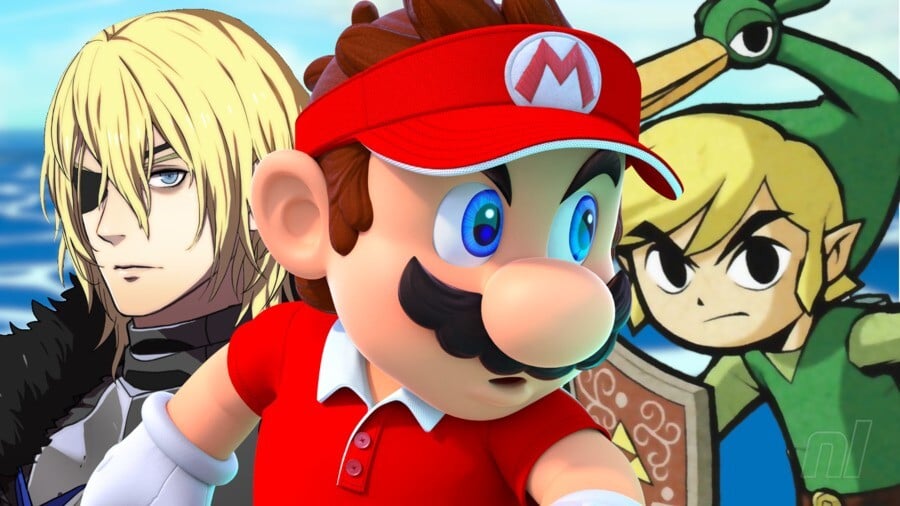
How did we do? Does this prediction look accurate, or is it off-base? Drop a comment below, and let us know what you think.



